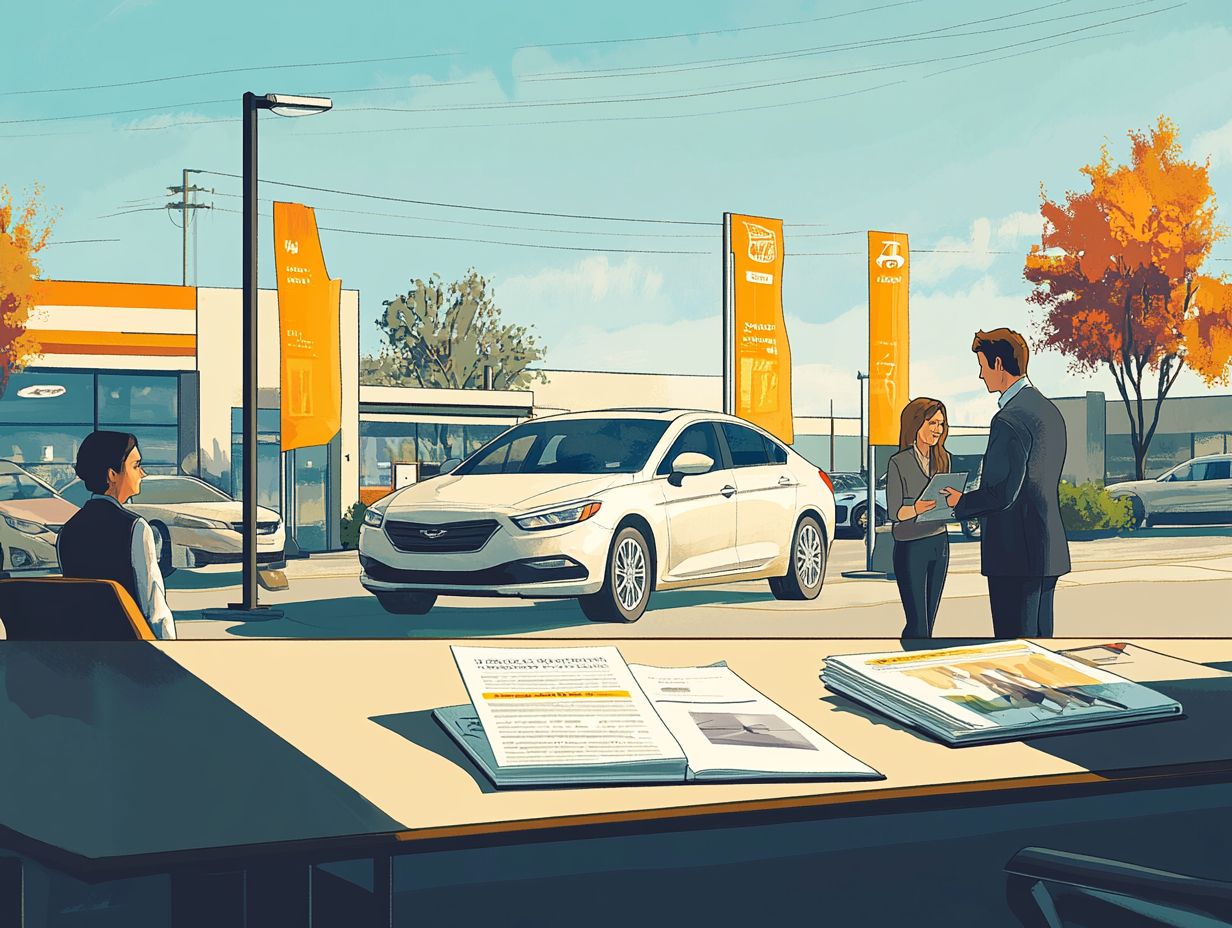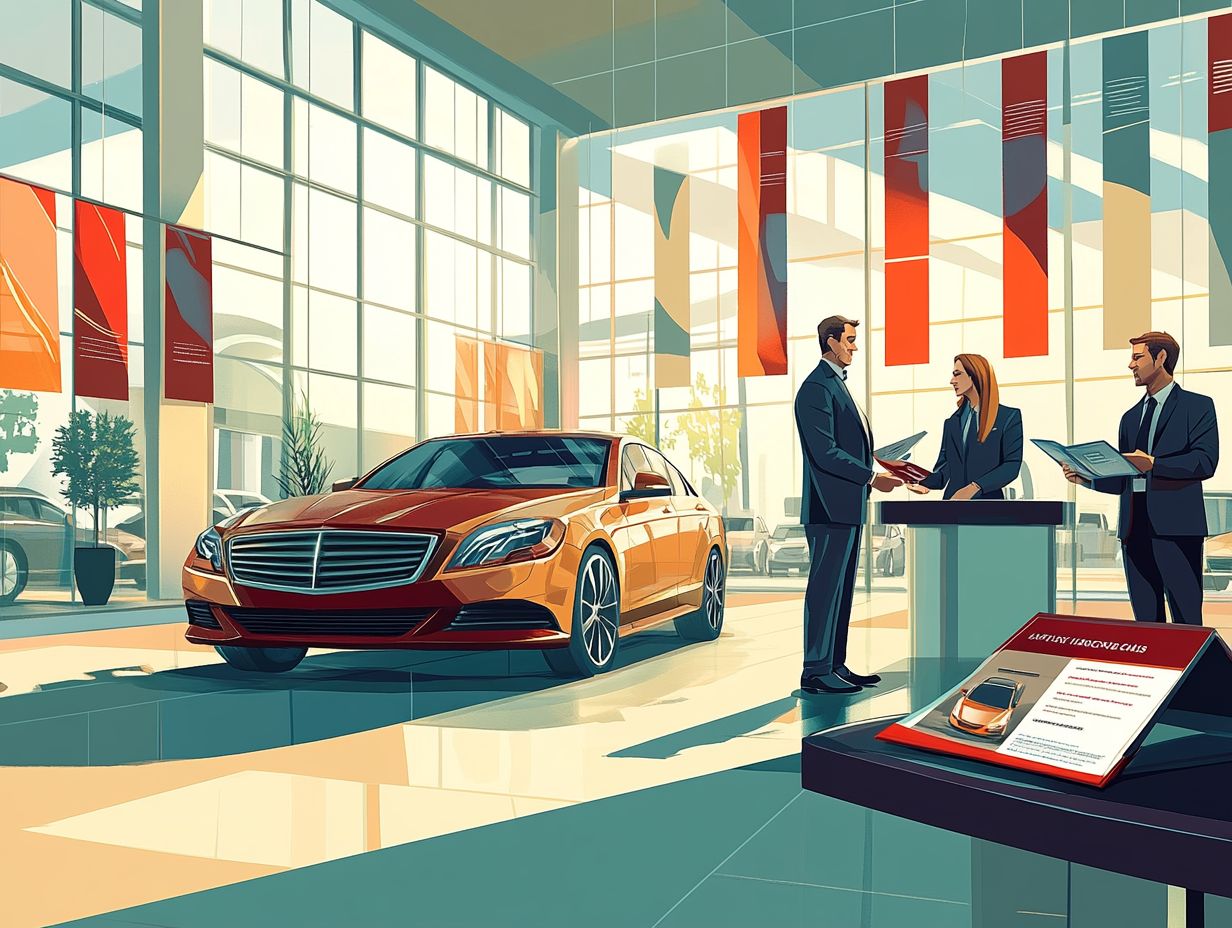What is Coverage for New Car Purchases?
Navigating the realm of car insurance can seem daunting, especially when you are in the market for a new vehicle. It is crucial to understand the various types of coverage available to ensure you are adequately protected on the road.
This article will serve as your guide through the intricacies of car insurance tailored specifically for new car purchases. You will discover what is included in your policy and what might be excluded, while we delve into the key factors influencing your coverage options. We want to help you find the perfect plan and provide valuable tips for saving on costs.
Immerse yourself in this knowledge to secure your investment and drive with confidence.
Contents
Key Takeaways:

- New car purchases require specific insurance coverage to protect your investment.
- Factors like car value and driving record can affect the coverage options and costs for your new car.
- Research and compare different coverage options to find the best fit for your budget and needs.
Understanding Car Insurance Coverage
Understanding car insurance coverage is crucial for new car owners, as it safeguards you against money problems arising from accidents or damages. There are various types of auto insurance available, including:
- Liability insurance
- Comprehensive coverage
- Collision coverage
Each type is designed to protect you and your vehicle in distinct ways while also satisfying state-mandated insurance requirements. By familiarizing yourself with these policies, you can navigate the often intricate world of car ownership, ensuring that you meet your consumer needs and fulfill your legal obligations.
Types of Coverage
It is important to be acquainted with several essential types of car insurance coverage that every driver needs to understand. This includes liability insurance, comprehensive coverage, and collision coverage. Each type addresses specific risks associated with car ownership.
Liability insurance is generally your first line of defense, covering damages or injuries inflicted on others in an accident where you are at fault. It provides vital financial protection against potentially crippling lawsuits.
Comprehensive coverage protects you from non-collision incidents like theft, vandalism, or natural disasters, ensuring you are not left grappling with unexpected financial burdens.
Collision coverage covers the expenses involved in repairing your vehicle after an accident, regardless of who is at fault, offering you a sense of security in scenarios that might otherwise leave you feeling overwhelmed by repair costs. Understanding these types of coverage is essential for securing your overall financial well-being as a driver.
Coverage for New Car Purchases
When you purchase a new car, securing the right coverage is essential to protect your investment and provide you peace of mind as you drive.
New car insurance usually includes a range of coverage options, such as comprehensive coverage, collision coverage, and even new car replacement. These components work together to create a robust insurance portfolio that shields your vehicle from unexpected events.
What is Covered?
New car insurance typically includes various essential elements. This encompasses comprehensive coverage, which protects you from damages unrelated to collisions, and collision coverage, which addresses damages from crashes. Your policy may also include personal injury protection and roadside assistance.
Comprehensive coverage is particularly valuable if you live in areas prone to natural disasters or theft, offering peace of mind against unforeseen events. For instance, if your new vehicle suffers damage from hail or gets stolen, this coverage takes care of the repair or replacement costs.
On the other hand, collision coverage becomes essential after an accident, ensuring that the expenses for repairs from impacts with other vehicles or obstacles are fully covered. Personal injury protection covers your medical expenses if you are hurt in an accident, easing your financial concerns.
Finally, roadside assistance can be a true lifesaver in emergencies like flat tires or engine failures, ensuring you receive prompt help no matter where you are.
What is Not Covered?

While new car insurance policies offer extensive coverage, it s essential to understand what s not included. Total loss due to negligence or certain natural disasters that may not meet insurance requirements can leave you in a tight spot.
That s where gap insurance comes in it covers the difference between your vehicle’s market value and any remaining auto loan balance. Understanding these exclusions allows you to make informed choices about your coverage options.
For example, many policies explicitly exclude damage from racing, intentional acts, or even driving under the influence. This could leave you facing significant out-of-pocket expenses in those unfortunate situations.
Natural disasters like floods or earthquakes might also be omitted. This underscores the importance of scrutinizing your policy details carefully.
Gap insurance acts as your financial safety net, ensuring you re protected if your car is stolen or totaled, particularly in those initial years when depreciation hits hard. By investing in this additional coverage, you can safeguard against potential financial pitfalls and drive with greater peace of mind.
Factors that Affect Coverage for New Car Purchases
Several key factors come into play regarding securing coverage for your new car. Your vehicle identification number (a unique code used to identify individual motor vehicles), driving history, and specific car features all influence what s available to you.
Insurers carefully assess these elements to determine premium costs and craft personalized insurance quotes that cater to your unique requirements.
Car Value and Model
The value and model of your car play a crucial role in shaping the insurance rates you encounter. Higher-end models often come with steeper premiums due to their elevated value and enhanced features.
However, these rates aren’t solely dictated by the price tag; they also consider safety ratings, repair costs, and the technology in the vehicle.
If you drive a luxury car loaded with advanced driver-assistance systems, you might even see a dip in some premiums because of the reduced accident risks. On the other hand, models commonly targeted by thieves usually result in higher rates.
Understanding these nuances enables you to make informed decisions about your policies, helping you strike the perfect balance between coverage and cost.
Driving Record and Location
Your driving record and location significantly influence your new car insurance coverage and premium costs. Insurers adjust rates based on the perceived risk associated with these elements.
Your history as a driver encompassing previous accidents, violations, and claims plays a pivotal role in determining your coverage costs. Insurers scrutinize these records to predict your future behavior, meaning safer drivers typically enjoy lower premiums.
Geographic factors are equally important. Certain areas may experience higher rates of accidents or theft, prompting insurance companies to offer varied coverage options. Regions with high populations or urban centers might face elevated rates due to increased risk, while rural areas could benefit from more favorable premiums.
Choosing the Right Coverage for Your New Car
Selecting the ideal coverage for your new car is a crucial decision. You need to compare different insurance providers.
Identify coverage limits that align perfectly with your needs, preferences, and budget. Assess customer service and claims handling to enhance your insurance experience.
Don t hesitate to consult with an insurance agent to address any coverage gaps. The right guidance can help you navigate your options effectively.
Factors to Consider

When you re considering insurance coverage for your new car, evaluating factors like premium costs, coverage limits, and the reputation of various insurance providers is essential for making a well-informed decision.
The premium costs impact your monthly budget directly. Finding the right balance is key. While lower premiums may look tempting, they often come with higher deductibles, which means the amount you pay before insurance kicks in, or limited protection. This can lead to unexpected expenses if you find yourself in an accident.
Understanding the coverage limits offered is vital to ensure you re fully protected against potential losses.
The reputation of your chosen provider can significantly influence your overall satisfaction. Diving into customer reviews and ratings offers valuable insights into how claims are handled, giving you peace of mind when it matters most. Analyzing these factors systematically enhances your decision-making process.
Cost-Benefit Analysis
Conducting a cost-benefit analysis is essential when searching for the best insurance policy for your new car. This process helps assess the relationship between premium costs and the various coverage options available.
By examining the trade-offs between lower premiums and potentially higher out-of-pocket expenses in the event of an accident, you gain insight into which policy truly offers value.
Evaluating factors like liability, collision, and comprehensive coverage becomes crucial, especially when considering your personal circumstances and driving habits. It s not just about snagging the cheapest option; it s about ensuring you have adequate protection in various scenarios.
A careful assessment helps you make informed decisions that balance affordability with necessary safeguards. This approach leads you to a choice that aligns with both your financial goals and your peace of mind.
Tips for Lowering Coverage Costs
You can effectively lower your coverage costs by employing strategic approaches. Consider:
- Taking advantage of available insurance discounts.
- Bundling multiple policies for better rates.
- Regularly shopping for insurance quotes online.
This proactive method helps you avoid unwelcome premium increases and ensures you get the best value for your coverage.
Discounts and Bundling
Utilizing insurance discounts and bundling policies can significantly reduce your premium costs, making auto insurance much more accessible for new car owners.
Many providers offer a variety of discounts that can work in your favor, such as:
- Safe driver discounts for those with spotless driving records.
- Multi-car discounts when you insure several vehicles under a single policy.
- Discounts for installing safety features like anti-theft devices.
If you choose to bundle your auto insurance with homeowners or renters insurance, you ll often unlock substantial savings, simplifying your financial management.
By embracing these strategies, you not only trim your expenses but also enhance your coverage options and enjoy superior customer service as part of a well-rounded plan.
Frequently Asked Questions
What is Coverage for New Car Purchases?

Coverage for new car purchases refers to the protection and benefits included in a car insurance policy, including coverage for sports cars for a newly purchased vehicle.
Do all car insurance policies include coverage for new car purchases?
No, not all car insurance policies include coverage for new car purchases. It’s important to check with your insurance provider to see if this coverage for rental vehicles is part of your policy.
What are some common benefits included in coverage for new car purchases?
Some common benefits may include gap insurance, replacement cost coverage, and new car replacement coverage. Want to know how to save on your next insurance policy? Start shopping for insurance quotes today to find the best deal!
What is Gap Insurance?
Gap insurance covers the difference between your car’s actual cash value and the amount you owe on a loan or lease. This type of insurance is especially helpful when buying a new car.
Do I Need Insurance for a New Car?
While not legally required, having insurance for your new car is vital. It can protect your investment and give you peace of mind.
How to Find the Best Insurance for My New Car?
Research different insurance policies from multiple providers to find the best one for your needs. Look at costs, coverage options, and customer reviews before deciding.






